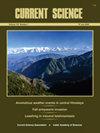Space technology support for development of agriculture in the North Eastern Region of India – scope and challenges
IF 1
4区 综合性期刊
Q3 MULTIDISCIPLINARY SCIENCES
引用次数: 0
Abstract
The North Eastern Region of India (NER) has tremendous scope for accelerating its growth in agriculture and allied areas through advanced data acquisition, interpretation and dissemination methods with geospatial technology. For several thematic applications, geospatial tools and techniques are being used to provide synoptic, cost-efficient and timely information for effective crop planning and monitoring in the region. A review of space applications in agriculture, horticulture, sericulture, land-use suitability, shifting cultivation, groundwater pro-specting, soil resources management, etc. has been made, highlighting the scope and limitation of using these advanced technologies. Satellite remote sensing has several limitations in NER, viz. small and fragmented farmlands, persistent clouds during monsoon, mixed farming, steep hills, etc. Considering these facts, unmanned aerial vehi-cles (UAVs) are used as an alternative for satellite remote sensing applications in agriculture. The increased availability of very high resolution satellite and UAV data will offer opportunities for innovative solutions to fulfil specific user needs of agriculture and allied sectors in NER.空间技术支持印度东北地区农业发展——范围和挑战
印度东北地区(NER)有巨大的空间可以通过先进的数据采集、解释和传播方法以及地理空间技术来加速其农业和相关领域的增长。在若干专题应用中,正在使用地理空间工具和技术为该区域有效的作物规划和监测提供概括性、成本效益高和及时的信息。综述了空间技术在农业、园艺、蚕桑、土地利用适宜性、轮作栽培、地下水勘探、土壤资源管理等方面的应用,指出了这些先进技术的应用范围和局限性。卫星遥感在东北地区有几个限制,即小而破碎的农田,季风期间持续的云,混合耕作,陡峭的山丘等。考虑到这些事实,无人驾驶飞行器(uav)被用作农业卫星遥感应用的替代方案。高分辨率卫星和无人机数据可用性的增加将为创新解决方案提供机会,以满足NER农业和相关部门的特定用户需求。
本文章由计算机程序翻译,如有差异,请以英文原文为准。
求助全文
约1分钟内获得全文
求助全文
来源期刊

Current Science
综合性期刊-综合性期刊
CiteScore
1.50
自引率
10.00%
发文量
97
审稿时长
3 months
期刊介绍:
Current Science, published every fortnight by the Association, in collaboration with the Indian Academy of Sciences, is the leading interdisciplinary science journal from India. It was started in 1932 by the then stalwarts of Indian science such as CV Raman, Birbal Sahni, Meghnad Saha, Martin Foster and S.S. Bhatnagar. In 2011, the journal completed one hundred volumes. The journal is intended as a medium for communication and discussion of important issues that concern science and scientific activities. Besides full length research articles and shorter research communications, the journal publishes review articles, scientific correspondence and commentaries, news and views, comments on recently published research papers, opinions on scientific activity, articles on universities, Indian laboratories and institutions, interviews with scientists, personal information, book reviews, etc. It is also a forum to discuss issues and problems faced by science and scientists and an effective medium of interaction among scientists in the country and abroad. Current Science is read by a large community of scientists and the circulation has been continuously going up.
Current Science publishes special sections on diverse and topical themes of interest and this has served as a platform for the scientific fraternity to get their work acknowledged and highlighted. Some of the special sections that have been well received in the recent past include remote sensing, waves and symmetry, seismology in India, nanomaterials, AIDS, Alzheimer''s disease, molecular biology of ageing, cancer, cardiovascular diseases, Indian monsoon, water, transport, and mountain weather forecasting in India, to name a few. Contributions to these special issues ‘which receive widespread attention’ are from leading scientists in India and abroad.
 求助内容:
求助内容: 应助结果提醒方式:
应助结果提醒方式:


